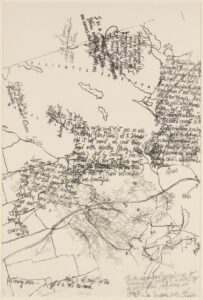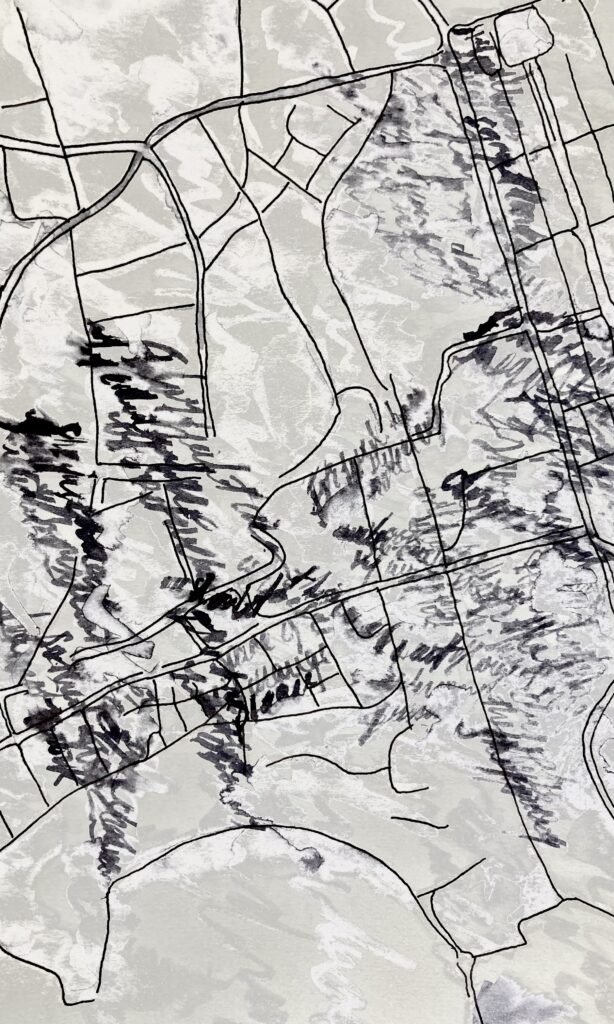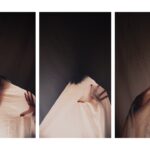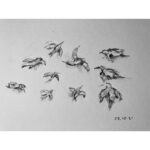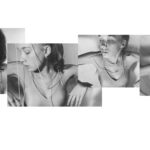Soundwalk
Videos taken on walk:
I hear:
- The chorus of birds
- Fractures of conversations
- Footsteps on crunching leaves
- Echos of traffic
- Groans of planes
- Rhythmic pattern of raindrops
- Gossip of schoolchildren
- Gentle whistle of father to baby
Initial Ideas:
- How the surrounding sounds change with the seasons
- Different snippets of conversation- what can you tell about people from this? Their relationship? (Peoplewatching/listening)
- The manmade noise vs nature
Development of Initial Ideas:
During the soundwalk, what I found to be the most interesting was the overheard snippets of passers-by conversations. I liked listening to how the different groups talked and interacted with each other. For example, the high-pitched excitement of gossiping school children followed by the hush, gentle humming of a father to his baby. I wanted to explore further how these different conversations with different expressions can be represented in a more visual sense.
One artist that caught my attention was John Cage, an American composer, music theorist, artist, and philosopher. His work in ‘John Cage: A Mycological Foray—Variations on Mushrooms’ really interested me. It explores his fascination with fungi, however, the pages that stood out were his lithograph prints which are overlays of text on Japanese Kitakata paper containing mycological notes by the scientist Smith which play across the page with poems by Cage interleaved with Cage’s random word lithographs. The composition of these Lithographs is something that I want to incorporate into my work: this overlapping a crisscrossing of words that represent the spatial, untamed nature of the placement of wild mushrooms.
Although I am not looking at mushrooms, I thought this composition could fit perfectly with my idea of overheard conversations. As I want to relate the place of those conversations onto a map, I would outline the map onto a piece of paper and write the snippets of the conversation onto where I had heard it, aiming to create a composition much like John Cage’s, as the placement would hopefully overlap so it constructs this layout of different types of people interviewing. Which draws on the rugged and wild nature that Cage puts forward within his work.
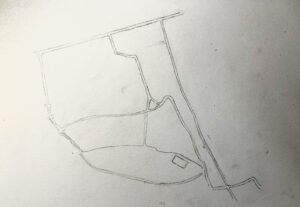 I started with mapping out the area in which I normally walk around, the central parts of Edinburgh. This way when I get down conversations, I have a rough placing for them. The placement of the conversations would become central to the art piece: it would create a composition where you can see noises overlap and places where there was more of a lack of noise, hopefully ending up with a piece where the writing of these conversations start to make up the map rather than the map itself.
I started with mapping out the area in which I normally walk around, the central parts of Edinburgh. This way when I get down conversations, I have a rough placing for them. The placement of the conversations would become central to the art piece: it would create a composition where you can see noises overlap and places where there was more of a lack of noise, hopefully ending up with a piece where the writing of these conversations start to make up the map rather than the map itself.  During my week, I decided to record the sounds of my walks from place to place, hoping to catch bits of conversations. Originally, I thought that there would be a lot more interaction between specific groups of people that I could overhear, however obviously I was only able to catch tiny snippets of lots of people’s conversation. Although this created a worry on whether the composition would be able to form like I wanted it to, with long paragraphs, it did overcome my initial problem of other people’s privacy being violated, as I caught very few words of what people were saying.
During my week, I decided to record the sounds of my walks from place to place, hoping to catch bits of conversations. Originally, I thought that there would be a lot more interaction between specific groups of people that I could overhear, however obviously I was only able to catch tiny snippets of lots of people’s conversation. Although this created a worry on whether the composition would be able to form like I wanted it to, with long paragraphs, it did overcome my initial problem of other people’s privacy being violated, as I caught very few words of what people were saying.
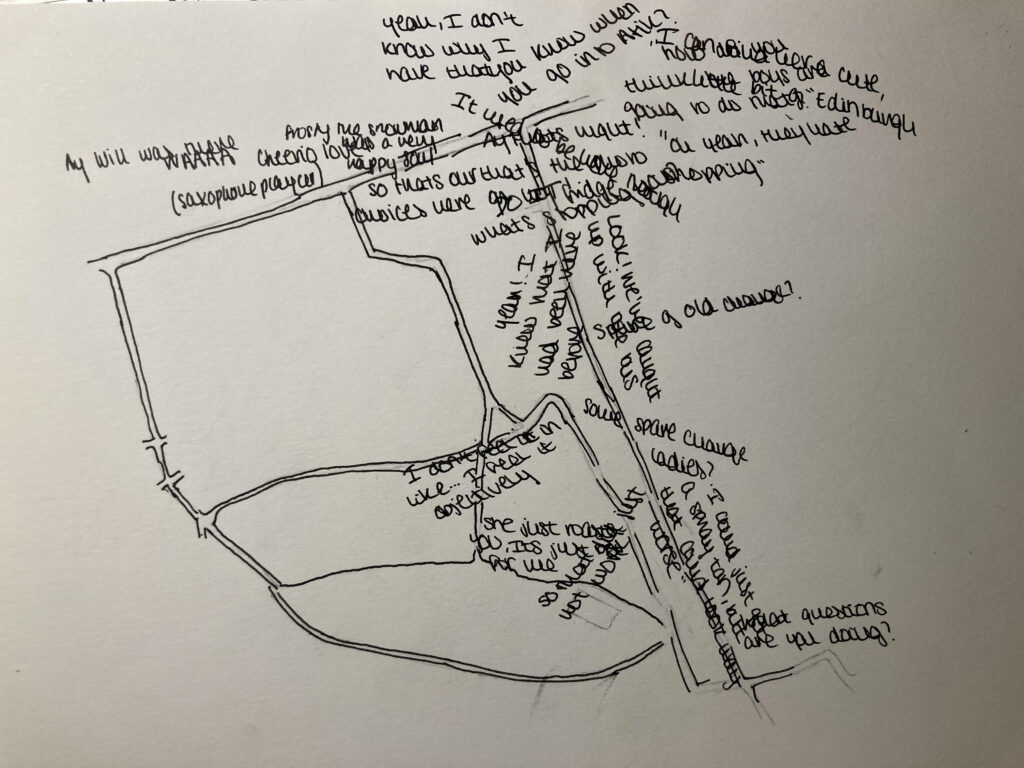
The next step was to write these onto the map, aiming to place them in the place that I had overheard them, in order to encapsulate the chaotic, interlacing nature of snippets of conversations from different groups of people that you hear whenever you walk around. Although placing the different conversations like this did manage to convey the disordered and muddled jumble of an accumulation of people, I thought that this can be pushed further.
I wanted my work to depict something more, I wanted the different types of people that are all within the same setting to be more prominent. Originally, I thought that this could be shown by using different handwriting, by listening to the tone and expression in people’s voices. However, only being able to catch small snippets of conversations and writing on a small scale made this quite tricky. To go forward with this then, I would want to be able to use a much bigger scale to write down the different snippets of conversation. In addition, instead of overhearing people on my walks, I would want to stay in the same place for a lot longer in order to focus on these different expressions and have more of a grasp on their attitudes within the conversation. In addition, I feel like using an ink pen doesn’t give the work the aesthetic I’m after. I would want to try out a calligraphy pen or use a type of print to give it more of a map-like quality.
After not feeling satisfied with the result from the work in which I had drawn inspiration from John Cage I decided to look at another artist, Leon Ferrari, to see if I could combine the ideas and results I had previously with other inspiration drawn from him.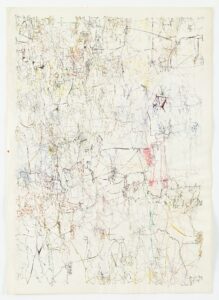
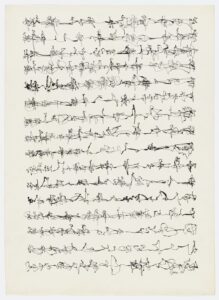
Leon Ferrari was an Argentinan conceptual artist who started using text in his work around 1962. His texts were not always readable, mainly stemmed from the political corruption in Argentina that resulted in corrupt media, therefore leading Ferrari to present words in art through a different medium. His work uses lines and letters to create an image of text that produces no clear message due to the loose, calligraphic style that he uses.
I thought that this could be incorporated into my work. When I was walking around, hearing snippets of conversations there was no clear message, just sentences and phrases that bared no context, alienated from any frame of reference. I thought I could combine these overheard conversations with Ferrari’s presentation of letters to give it that chaotic, unreadable nature. Also when listening back to my recordings, much of the conversations I hear get cut out or obscured by other noises, and I thought that this could also be fused into the work by using Ferrari’s composition.

Inspired by Ferrari, I decided to re-listen to some of the recordings that I took on my walks. Then, closing my eyes, write down what fragments of conversation I overheard to give it that messed up, illegible quality. I liked more how these turned out. By incorporating other sounds, or lack thereof, you get much more of a chaotic mess, relating to the jumble and mesh of sounds that you overhear on your walks. In addition, within this scribble, you have occasional words or sentences that come into it which was my aim in this project.
Going further, I would like to experiment with how I can make these scribbles have more of a map-like structure, rather than having a letter or a book composition. This is where I would like to draw inspiration from John Cage and his random word lithographs.
I decided to combine the inspiration taken from both Cage and Ferrari’s work, so I could create a piece that incorporates both the spatial reference of where I heard the conversations and the chaotic, jumble of the fragments of conversations that I heard to demonstrate their illegible, indistinct quality. To make this work I used an ink pen to draw the map of Edinburgh, referencing Cage’s work, then listening back on my audio, writing down with a paintbrush and ink the snippets of conversations relating to the style of Ferrari’s work. Then, I went over the background with water and a paintbrush while listening to the background sounds in my audio. This made the fragments of conversations I had written down much more illegible, which is what I was trying to achieve as I wanted to encompass how the conversations on my audio often get drowned out by other sounds like traffic, wind etc.
I decided to edit the photo of my work, heightening the brightness and exposure so the water in the background became more prominent. It also added an old, faded quality to my work, which I liked as it is reminiscent of an old map.

